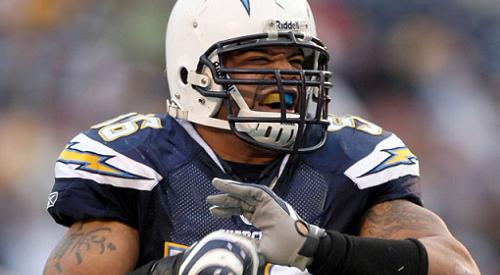
The steroid presence in the NFL
One of the most remarkable stories of the last decade has been the increased awareness of steroids and other performance-enhancing drugs, which went from subjects primarily discussed in weightlifting circles to national media debates, criminal trials and FBI investigations.
The effects of PEDs are still hotly debated, but substances that could potentially increase strength, muscle or recovery times would seem like a natural fit for a physical game like football with its laundry list of weekly injuries. Some football players have run afoul of drug tests or otherwise been caught with banned substances, like Shawne Merriman and Brian Cushing. CFL long-snapper Jordan Matechuk was recently caught with “543 anabolic steroid pills, 262 millilitres of anabolic steroids in liquid form, 1.25 grams of marijuana, 19 syringes, and 51 replacement needles” at the U.S. border.
Despite those cases, though, most of the focus in PED stories has been on other sports such as baseball, cycling and track and field, and there’s been very little public outrage over drugs in football.
Will Carroll of NumberFire has written about injuries, PED use and other elements of sports for Sports Illustrated, ESPN and Football Outsiders. He also wrote a book on the matter, The Juice: The Real Story of Baseball’s Drug Problems.
Carroll said he thinks the decreased outrage over drugs in football isn’t thanks to more effective testing programs or less athletes taking PEDs, but rather the NFL’s success in controlling the message.
“The NFL’s policy has been about controlling the public reaction, not controlling the substances,” Carroll said. “I don’t think anyone believes that PEDs aren’t being used in some format, but people don’t have the up-in-arms-ness about football that they do about baseball (or cycling).”
[php snippet=1]
Carroll said the differences between football and baseball players’ physiques, as well as the lack of potentially drug-fueled record chases, have been important reasons why there hasn’t been that public outrage over PEDs in the NFL.
“We’re used to physical freaks in football and Merriman was an MVP, not a record breaker,” he said. “Again, the NFL has controlled public relations, MLB has controlled the substances.”
Carroll said there isn’t a lot of data available on levels of PED use in football, but he doesn’t think it’s dropped off notably despite less stories on the subject in the last few years.
“I don’t believe there has been a significant reduction in anabolic drug use (which is way more than steroids) in the NFL in the last decade,” he said. “I don’t think it’s universal, but I have to believe based on the best evidence that it’s not insignificant.”
He said there’s plenty to suggest that players are deriving substantial benefits from those PEDs, too.
“Bigger, stronger, faster; which of those doesn’t help a football player?” Carroll said. “Watch a high school player – a blue-chip recruit that’s already a top talent – bulk up in his freshman year. Natural? Better workouts? Better coaches? Training table? Sure, to some extent, but as players move up the ladder, some need extra help and some ‘do it the easy way.’ Steroids work, no question. Other anabolic agents work. Even hGH, the red herring of the PED world, works to an extent (especially in a stack).”
Carroll said the NFL could improve its drug-testing program, but it would take substantial will and effort, as the current program falls far short of the standards set up by organizations like the U.S. Anti-Doping Agency and the World Anti-Doping Agency that conduct drug testing of Olympic hopefuls. He said the league may not want to go to those standards, as they could case a barrage of positive tests and negative stories.
“Do you want to control the media or the substances? If the latter, how much?” Carroll asked. “The NFL’s recent threat of turning their testing program over to USADA was laughable. The NFL’s list, testing procedure, and location control are nothing compared to a WADA program. Just on location control, we’d lose 10 percent of players. The penalties would have to be negotiated, but would be massive comparatively.”
Carroll said he does think the public is still generally against PED use, and that could motivate the NFL to take a firmer stand in the next five years. However, that could be dampened by both the development of more inventive ways to cheat and the league’s ongoing control of the message.
“American society won’t allow open use, and I think we’ll see a shift towards increased enforcement until we lose control with biomedical techniques like stem cells and genetic doping,” Carroll said. “The public will care, but the incentives will still be in place and the NFL will likely still control the message pretty well.”
[php snippet=1]

